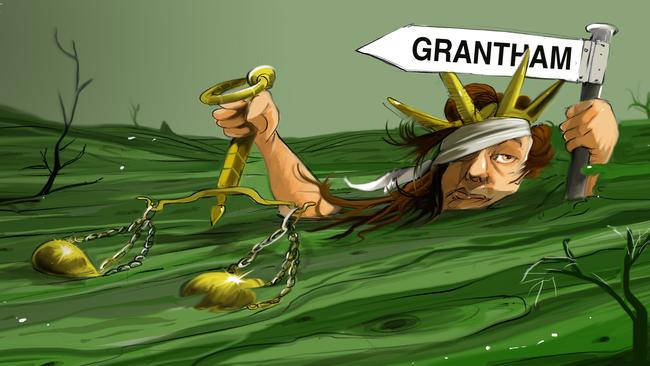
A JUDICIAL inquiry into the blunders of an earlier judicial inquiry may sound like prudential overkill, even in these navel-gazing times. Nevertheless, a review of the proceedings of Catherine Holmes’s Queensland Floods Commission would be an instructive exercise and might possibly reduce the chances of such a shambolic exercise happening again.
Even before the commission’s report was published, it was apparent something was badly amiss. After declaring its hearings over, the commission was obliged to resume sessions to consider crucial evidence on the management of Wivenhoe Dam, unearthed not by the commission’s well-resourced team of “experts” but by The Australian’sHedley Thomas.
Now The Australian has shamed Holmes’s inquiry again in a manner that should eradicate any residual credibility it has.
The commission, we now know, made a series of elemental yet critical mistakes. It made these mistakes because it devalued the evidence of witnesses who watched the floods unfold in real time. Rather than carefully evaluating their testimony and the abundant physical evidence, it outsourced its work to a panel of experts who staked the inquiry’s reputation on theoretical models rather than actual events.
More people died in Grantham in an hour than in any other single flood event in the whole of that dreadful Queensland summer. They died within a 500m radius of one another.
The 12 victims included a one-year-old who was torn from her exhausted mother’s arms. Three people died when a brick veneer house collapsed under the force of the water. A volunteer rural fireman thought his family would be safe in the cab of his fire truck. Yet the vehicle was tossed on the wave of water as if it were a weekend runabout. His wife, 12-year-old son and five-year-old daughter died.
So how many pages of the 653-page floods commission report were devoted to this extraordinary event? Grantham is mentioned in just 28 of them and the two in the index hardly count. Neither do the references on three introductory pages or the nine where the word Grantham appears only in the footnotes.
The five pages that consider Grantham’s post-flood recovery, the three on the local emergency response and the one on the break in the energy supply are, with respect, side issues.
Apart from six passing references, the circumstances of the actual flood in Grantham are confined to just 1½ pages.
Local voices were heard at two community gatherings yet the commission admits “no formal evidence was taken”. Holmes’s report says the meetings were “a useful way for the commission to hear directly from members of the Lockyer Valley community what they regarded as the questions needing to be considered by the commission”.
The conceit of that sentence is breathtaking. What would the little people of Grantham know about anything? It is, after all, a pocket of exceptional educational deprivation, a town so low on the socioeconomic scale that it almost falls off the bottom.
“We were all treated like stupid problems basically, you know, like hillbilly hicks,” said Marty Warburton, who runs Grantham’s service station.
Yet Warburton, and many others, knew the Grantham flood started with the collapse of a dam wall, on the edge of Wagner’s quarry, several kilometres upstream.
Flood water covering an area of perhaps 100ha, 2.5m deep in parts, built up behind the quarry wall. When the quarry wall gave way, millions of tonnes of water were released, forming a wave more than 2m high.
Yet the commission concluded the quarry’s earthworks had actually eased the flood. It based this inherently improbable finding on a single survey by hydrologist Phillip Jordan, whose assessment relied almost entirely on computer modelling.
It has taken more than four years, and a considerable investment by The Australian, to produce a more credible explanation. An independent study by DHI found Jordan’s study was deeply flawed. Three glaring errors are highlighted.
First, Jordan took his readings from the peak of the flood, yet the damage to lives and property occurred at the onset of the flood as the wall of water smashed, without warning, into buildings and cars.
Second, having run the data through the computer, Jordan should have checked it against the abundant physical evidence on the ground and witness accounts. This he conspicuously failed to do. If he had he would have concluded that his computer was talking out its rear air vent.
Third, Jordan was incapable of telling the time. He could not say with any certainty when the flood hit Grantham and takes a stab at a quarter past three. In fact, the evidence puts the timing of the flood 45 critical minutes later. Telstra records show that when Jon Sippel telephoned Tom Friend to tell him he had just witnessed the dam bursting, barely 100m away, it was seven minutes to four. Danny McGuire’s call to Fire Service HQ from his home on the Gatton-Helidon Road was made at 4.01 and 57 seconds.
In this case pedantry is important because the longer the water was held back behind the levee at Wagner’s quarry, the greater the accumulated volume and the greater the force when released.
If Annastacia Palaszczuk’s fledgling government wants to avoid being tarnished by the self-interested, election-driven actions of Anna Bligh’s government during and after the flood, she must commission a fresh inquiry into the Grantham disaster.
It is surely time for a Queensland premier to take a stand on principles, to take a stand for the people of Lockyer Valley, and take a stand against the politics of pusillanimity that have so far prevented the nation facing the truth.


